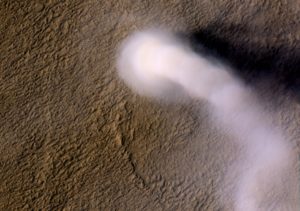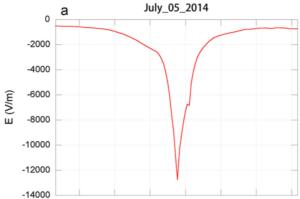dust devils
All posts tagged dust devils

A martian dust devil observed by the HiRISE instrument, in orbit around Mars.
Dust devils, whirling columns of fine particulates, have captured imaginations going back at least to the ancient Greeks, but their inner workings continue to confound and surprise scientists. Dust devils are common in arid regions on Earth, and on Mars, where “arid” doesn’t begin to describe the climate, dust devils are ubiquitous.
Especially puzzling, dust devils are better at lifting dust into the air than they ought to be. For example, in lab-simulated vortices, even when the winds are barely above a breeze, small dust grains seem to miraculously levitate and dance. So it seems that some force other than just wind must be important for lofting dust in devils. During our research group meeting today, we discussed a recent study by Gabriele Franzese and colleagues looking at one possibility: electric fields within dust devils.
As dust grains clatter around within the turbulent body of a devil, they can collide over and over again, which can transfer charge between the grains similar to the process that generates static electricity. And, for reasons that aren’t well understood, small grains like to collect negative charge.
Since small grains can be more easily lifted than large ones, small, negatively charged grains end up at higher altitude than large grains in dust devils, resulting in charge separation and a electric field. In the same way static electricity can lift small pieces of paper, these electric fields can draw in more dust grains and help explain the surprising ability of devils to lift shrouds of dust.

From Figure 5 of Franzese et al. (2018), the electric field associated with a dust devil.
For their field study of active dust devils, Franzese and colleagues set up meteorological equipment in the deserts of Morroco and left it there, steadily measuring wind speeds, dust loading, and electric fields. As dust devils skittered past their instruments, they registered as dips and spikes in the data logs. After recovering the instruments and analyzing the data, Franzese and colleagues found more than 500 dust devils had visited their instruments over a three month time-span.
The dust devils displayed a wide variety of shapes, sizes, and, most importantly, electric fields. The picture at left shows the electric field measured for one particularly strong dust devil. In this case, the devil exhibited an enormous electric field, 12,000 V/m. For comparison, such strong electric fields usually seen within storm clouds. Franzese and colleagues show that the strength of field measured for a devil correlates one-to-one with the amount of dust within the devil, so it seems likely electric fields do play some role in the lofting the dust.
Since humidity in the air can wick away static charge, dust devils on arid Mars probably exhibit even stronger electric fields than on Earth, which may help explain why martian devils are so much more common there: even faint whirlwinds manage to lift dust. These same electric fields could also present a danger to human exploration of Mars, though, potentially damaging sensitive electronics. Or at the very least, making a case of the Mondays even worse.
Using an Instrumented Drone to Sample Dust Devils
Dust devils are low-pressure, small (many to tens of meters) convective vortices powered by surface heating and rendered visible by lofted dust. The dust-lifting capacity of a devil likely depends sensitively on its structure, particularly the wind and pressure profiles, but the exact dependencies are poorly constrained. In this pilot study, we flew an instrumented quadcopter through several dust devils to probe their structures.
Dust devils occur ubiquitously on Mars, where they have been observed from space and from landed spacecraft. Martian dust devils may present a hazard to exploration of the planet, but they have also lengthened the lifetime of the Mars rovers.
Join the Physics Department on Friday, Sep 1 at 7:30p in the Multi-Purpose Classroom Building, room 101 to hear about research on terrestrial analog dust devils conducted by Boise State’s own Prof. Brian Jackson. He will discuss a recent pilot study using an instrumented quadcopter to sample active dust devils and will present encounter footage collected onboard the drone.
After the presentation at 8:30p, we will stargaze on the roof of the Brady Street Parking Garage.
The entire event is free and open to the public. Contact Prof. Brian Jackson (bjackson@boisestate.edu – astrojack.com – @decaelus) with any questions.
